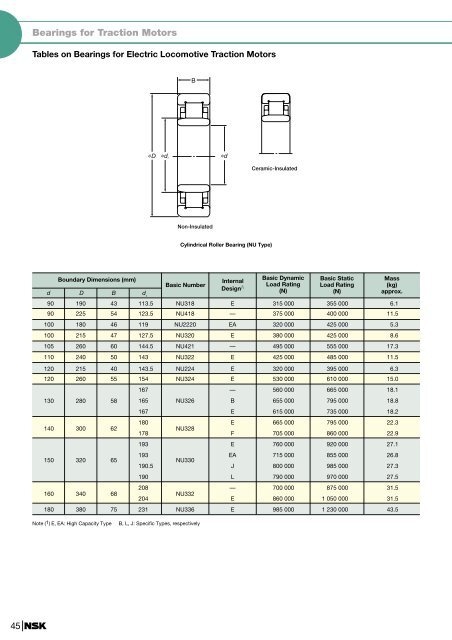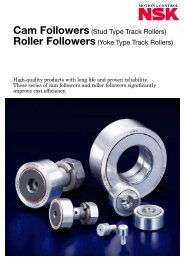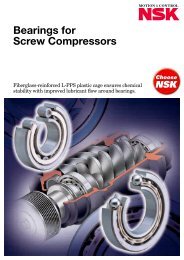Introduction to Axle Bearings for Railway Rolling Stock
Introduction to Axle Bearings for Railway Rolling Stock
Introduction to Axle Bearings for Railway Rolling Stock
You also want an ePaper? Increase the reach of your titles
YUMPU automatically turns print PDFs into web optimized ePapers that Google loves.
<strong>Axle</strong> <strong>Bearings</strong> <strong>for</strong> <strong>Railway</strong> <strong>Rolling</strong> S<strong>to</strong>ck<br />
Cylindrical Roller <strong>Bearings</strong> Combined with<br />
Ball <strong>Bearings</strong><br />
Cylindrical roller bearings (CRBs) have high load-carrying<br />
capacity because of the linear contact between their<br />
rollers and raceways. They are capable of high running<br />
speeds because of their relatively small friction coefficient<br />
and they offer advantages in maintenance because they<br />
are more easily disassembled, inspected and<br />
reassembled. Furthermore, they allow the free setup of<br />
their axial clearance.<br />
However, ordinary CRBs require another bearing <strong>to</strong> handle<br />
axial loads, increasing the number of parts required <strong>for</strong><br />
supporting the axle journal. Usually, the axial loads are<br />
borne by a single-row radial ball bearing such as a deep<br />
groove ball bearing or an angular contact ball bearing<br />
installed between the bearing box front cover and the axle<br />
end. To absorb axial loads, a rubber buffer or a coned disc<br />
spring is placed between the ball bearing’s outer ring and<br />
the bearing box front cover. Sealing is provided by a seal<br />
between the rear cover and the bearing box. In Japan,<br />
bearings of this type of construction have long been used<br />
and referred <strong>to</strong> as “journal box type” bearings. For<br />
conventional rolling s<strong>to</strong>ck, bearing boxes containing a<br />
double-row cylindrical roller bearing <strong>for</strong> radial loads and<br />
an angular contact ball bearing with a rubber buffer <strong>for</strong><br />
axial loads have been used <strong>for</strong> many years. Initially <strong>for</strong><br />
Shinkansen trains, bearing boxes essentially identical <strong>to</strong><br />
the conventional type were employed, although the<br />
combination of an angular contact ball bearing and a<br />
rubber buffer was replaced early on by a deep groove ball<br />
bearing and a coned disc spring.<br />
Cylindrical Roller <strong>Bearings</strong> with Ribs<br />
With this type of bearing, axial load is borne by ribs on the<br />
outer and inner rings and by the ends of the rollers. This<br />
type is referred <strong>to</strong> as the UIC type and has been<br />
standardized in Europe. When compared with cylindrical<br />
roller bearings combined with ball bearings, the UIC type<br />
offers the advantages of reduced cost and simpler and<br />
more compact housing construction owing <strong>to</strong> the absence<br />
of the ball bearing. Formerly, it was believed that<br />
insufficient load-carrying capacity of the bearing ribs could<br />
lead <strong>to</strong> problems at high speeds. However, with the<br />
adoption of this type of bearing <strong>for</strong> the 300 Series<br />
Shinkansen, it was demonstrated that improved design of<br />
the ribs and roller ends coupled with better finishing<br />
accuracy eliminated such problems. This type of axle<br />
bearing can be constructed with a sealing arrangement<br />
between the rear cover and the bearing box or, as<br />
described in the section on RCT bearings, they can have<br />
an internally sealed construction.<br />
26





